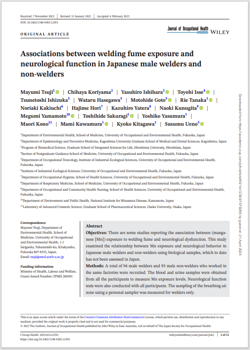#0157 Sparks of Concern: Exploring Welding Fume Exposure and its Association with Neurological Functions

Sparks of Concern: Exploring Welding Fume Exposure and its Association with Neurological Functions
In Japan, welding, the process of joining metal parts together by melting them with heat or pressure, is a common occupation. Approximately 180,000 workers are engaged in metal welding and fusion cutting, comprising about 0.3% of the total working population. In 2020, the Japanese government announced plans to partially revise laws and regulations aimed at strengthening measures to prevent health hazards among welders associated with manganese (Mn) exposure and welding fumes.
Researchers in Japan have conducted few studies on the neurotoxicity or respiratory toxicity experienced by welders exposed to Mn. In this particular study, 94 male welders from 7 factories in Japan participated. Additionally, 95 male non-welders from the same factories were recruited as control participants. The participants, aged 20 years or older, were recruited between April 2021 and June 2022.
Participants completed a self-administered questionnaire. The researchers measured hand grip strength in both the dominant and non-dominant hands using a digital grip strength dynamometer. Finger tapping measures the maximum speed of repetitive finger movements, utilizing the index and middle fingers of the dominant and non-dominant hands, respectively. Additionally, researchers assessed the Working Memory Index (WMI) and conducted blood and urine sampling.
A professional measurer from an external organization (the Japan Industrial Safety and Health Association) conducted breathing air zone sampling for welders using a personal sampler in accordance with the guidelines for personal exposure measurements of chemical substances established by the Japan Society for Occupational Health.
The welders exhibited stronger grips, fewer finger tappings, and lower WMI scores compared to non-welders. No significant relationship was found between grip strength and finger tapping for dominant and non-dominant hands as well as blood Mn concentrations. Non-welders displayed a mild relationship between low WMI scores and high blood Mn levels. However, the association between welders' WMI scores and blood Mn levels showed the highest statistical significance.
Mn concentrations in the environment, the duration of Mn exposure, and the usage of personal protective equipment to prevent Mn exposure are vital factors in determining whether Mn exposure affects neurological function. Safety measures outlined in the Hazards Prevention Ordinance are crucial for ensuring workplace safety. Under the regulations concerning Specified Chemical Substances, doctors have the authority to order the measurement of Mn concentration in urine or other biological samples from welders as part of a secondary health checkup.

Link to the original journal article:
https://academic.oup.com/joh/article/65/1/e12393/7479298
Title of the paper:
Associations between welding fume exposure and neurological function in Japanese male welders and non-welders.
Authors:
Mayumi Tsuji, Chihaya Koriyama, Yasuhiro Ishihara, Toyohi Isse, Tsunetoshi Ishizuka, Wataru Hasegawa, Motohide Goto, Rie Tanaka, Noriaki Kakiuchi, Hajime Hori, Kazuhiro Yatera, Naoki Kunugita, Megumi Yamamoto, Toshihide Sakuragi, Yoshiko Yasumura, Maori Kono, Mami Kuwamura, Kyoko Kitagawa, Susumu Ueno




